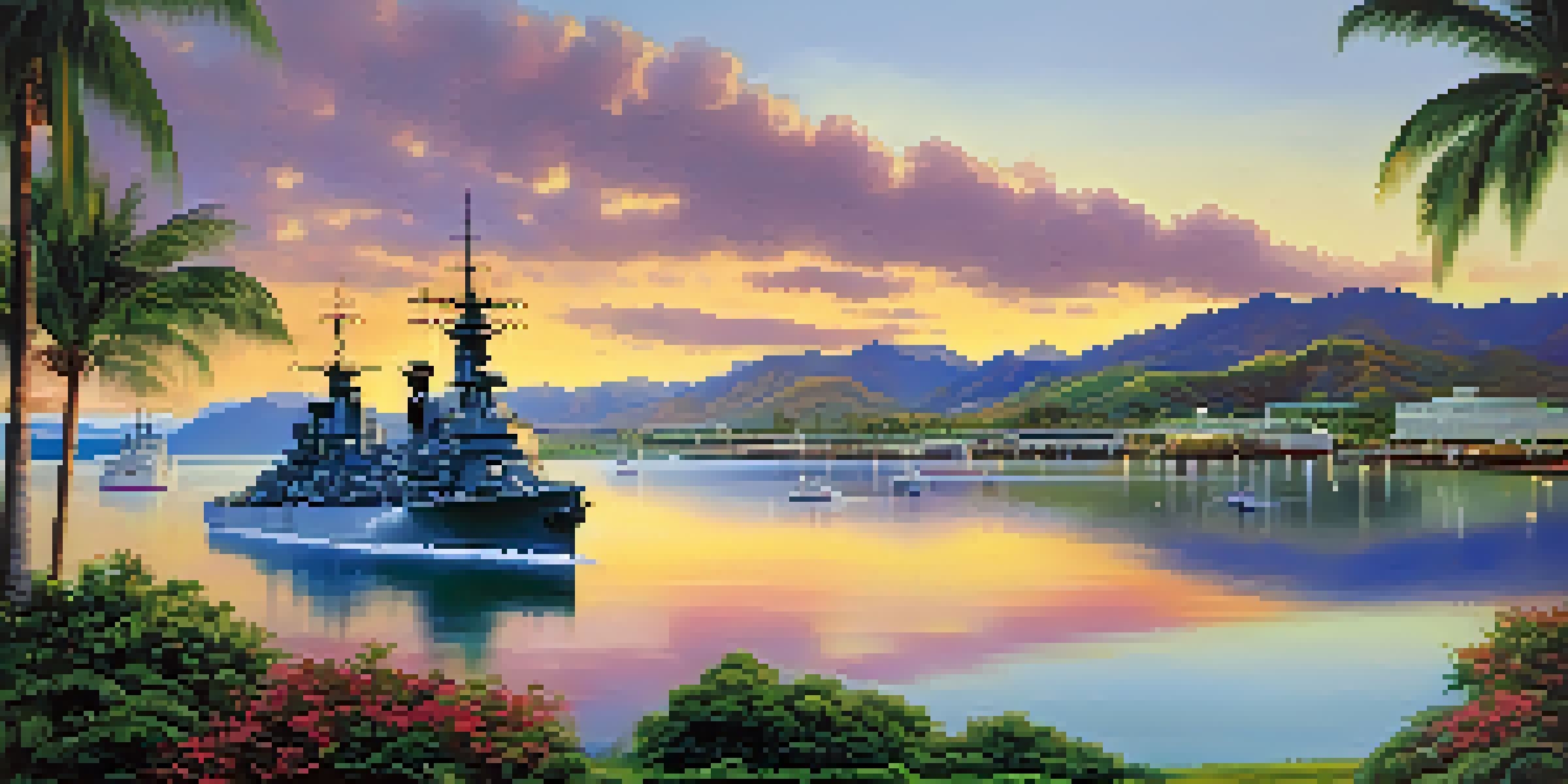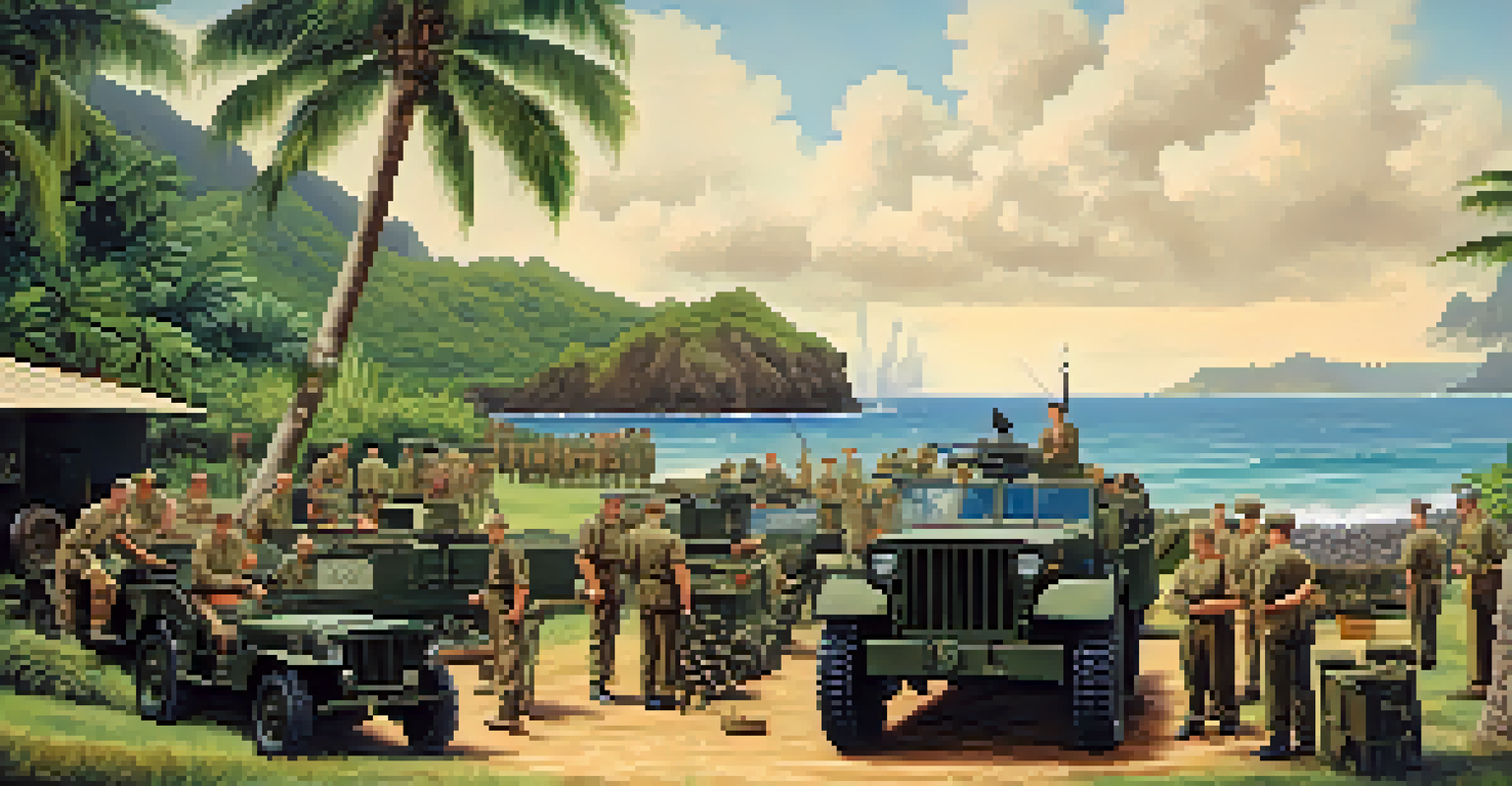Impact of Hawaii's Geography on WWII Naval Operations

Hawaii’s Strategic Location in the Pacific Theater
Hawaii's position in the central Pacific made it a crucial hub during World War II. Located approximately halfway between the U.S. mainland and Asia, it served as a vital refueling and staging area for naval operations. This geographical advantage allowed the U.S. Navy to project power across vast distances, coordinating efforts with allies and launching counter-offensives against Japan.
In war, the moral is to the physical as three is to one.
The islands' proximity to enemy territories meant that naval forces could quickly mobilize and respond to threats. For instance, following the attack on Pearl Harbor, Hawaii became a launching point for numerous operations aimed at reclaiming lost territories in the Pacific. This centrality not only facilitated swift military action but also helped in gathering intelligence on enemy movements.
Moreover, Hawaii’s geographic isolation also played a role in securing it as a stronghold. The surrounding waters served as a natural barrier, making it challenging for enemy forces to invade. This protective aspect of Hawaii’s geography allowed the U.S. to fortify its defenses and maintain a continuous naval presence in the region.
Pearl Harbor: A Key Naval Base
One of the most significant impacts of Hawaii's geography was the establishment of Pearl Harbor as a major naval base. Its deep-water harbor provided an excellent location for docking battleships and other vessels, making it a strategic asset for the U.S. Navy. The sheltered waters allowed for easy repairs and maintenance, which were essential during prolonged military campaigns.

Pearl Harbor's location also enabled efficient logistics and supply routes. With direct access to the Pacific, supplies, reinforcements, and equipment could be transported swiftly to support ongoing operations. This logistical advantage was crucial for sustaining the war effort, particularly during critical moments of conflict.
Hawaii's Strategic Military Hub
Hawaii's central location in the Pacific made it an essential staging area for U.S. naval operations during WWII.
However, the attack on Pearl Harbor on December 7, 1941, showcased vulnerabilities as well. Despite its strategic advantages, the surprise attack underscored the need for enhanced defensive measures. In the aftermath, the U.S. Navy worked to improve its security protocols, learning valuable lessons about the importance of preparedness in a geographically strategic location.
Island Hopping Campaign: Utilizing Geography for Offensives
The island-hopping strategy employed by the U.S. during WWII was heavily influenced by Hawaii's geography. This approach involved capturing strategically important islands while bypassing others, allowing forces to gain critical positions closer to Japan. Hawaii served as the launchpad for these operations, facilitating the movement of troops and resources to targeted islands.
Geography is destiny.
By using Hawaii as a staging ground, the U.S. Navy could effectively coordinate operations across the Pacific. For example, the successful campaigns in places like Tarawa and Iwo Jima were made possible by the logistical support and planning that originated from Hawaii. This geographic advantage played a significant role in the overall success of the island-hopping strategy.
Additionally, the geography of the islands themselves, with their varied terrain and resources, influenced the choice of targets. Each island presented unique challenges and opportunities, making the selection process critical. Thus, Hawaii's diverse geography not only shaped military strategy but also highlighted the importance of adapting to local conditions.
Challenges of Naval Operations in Hawaiian Waters
While Hawaii's geography offered numerous advantages, it also presented unique challenges for naval operations. The surrounding waters were often subject to unpredictable weather and rough seas, which could disrupt shipping lanes and military maneuvers. These natural obstacles required careful planning and agility from naval commanders.
Additionally, the volcanic islands themselves posed navigational difficulties. The presence of reefs and shallow waters around many of the islands increased the risk of grounding vessels, necessitating skilled navigation and awareness of local conditions. This aspect of Hawaii's geography emphasized the importance of training and preparation for naval crews.
Pearl Harbor's Dual Role
Pearl Harbor served as a vital naval base for logistics and operations, while also revealing critical vulnerabilities.
Moreover, the emotional and psychological toll of operating in such a remote location cannot be overlooked. The isolation of Hawaii meant that soldiers and sailors were often far from home, which could affect morale. Commanders had to consider not only the logistical aspects of operations but also the welfare of their troops stationed in this strategic yet challenging environment.
Cultural and Social Impacts of Military Presence
The military presence in Hawaii during WWII significantly impacted the local culture and society. As thousands of servicemen flooded the islands, interactions between military personnel and local residents flourished. This blending of cultures led to the exchange of ideas, traditions, and even culinary influences, leaving a lasting mark on Hawaiian society.
However, the influx of military personnel also brought challenges, including increased demands on local resources and infrastructure. The rapid population growth strained housing, transportation, and services, necessitating adaptations by both the military and the local government. This dynamic highlighted the interconnectedness of military operations and civilian life in Hawaii.
Additionally, the presence of diverse military units from various regions of the U.S. promoted a sense of unity among soldiers. As they trained and fought together, they developed bonds that transcended their geographical origins. This camaraderie not only enhanced operational effectiveness but also fostered a shared sense of purpose in the war effort.
Post-War Influence on Hawaii's Development
The end of WWII marked a significant turning point for Hawaii, with its geography continuing to shape its future. The strategic military installations that were established during the war laid the groundwork for Hawaii's ongoing role in U.S. defense strategy. Even after the war, the islands remained home to numerous military bases, which contributed to the local economy and job market.
In addition to military influence, Hawaii's geographic beauty and unique culture attracted tourism, further transforming its economy. The post-war era saw a boom in travel to the islands, as people sought to experience the natural wonders and rich cultural heritage that had been highlighted during the war. This shift toward tourism was a direct reflection of Hawaii's geographical appeal.
Cultural Shifts from Military Presence
The influx of military personnel during WWII significantly influenced local culture and society in Hawaii.
Furthermore, the legacy of WWII in Hawaii also brought about changes in infrastructure and urban development. The need to accommodate a growing population and the influx of tourists led to improvements in transportation and public services. This evolution showcased how the geographic and historical significance of Hawaii continued to shape its trajectory long after the war.
Conclusion: Geography's Lasting Impact on Naval Strategy
In conclusion, Hawaii's geography played a pivotal role in shaping naval operations during WWII. Its strategic location, natural resources, and unique challenges influenced military strategies, logistics, and interactions with local communities. The lessons learned from these operations have had lasting implications for naval tactics and global military strategy.
As we reflect on this period, it's essential to recognize how geography can dictate the course of historical events. Hawaii's islands not only served as a battleground but also as a melting pot of cultures and ideas, underscoring the interconnectedness of military and civilian life.

Ultimately, the impact of Hawaii's geography on WWII naval operations illustrates the importance of location in military strategy. It reminds us that in both history and modern times, the lay of the land can shape not just battles, but also the lives of those who inhabit it.